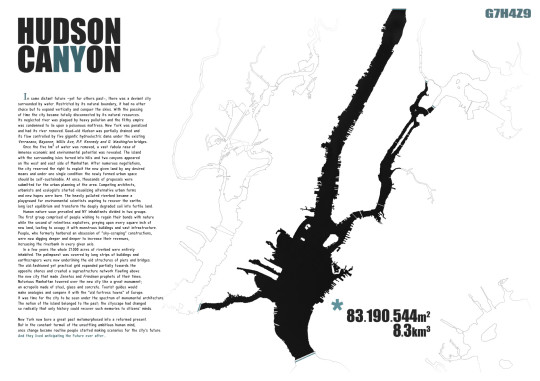Info:
Title: Hudson Canyon - Code: G7H4Z9Contest: NY / 2012
By: A. Olga Kefalogianni - L. Antonios Vassiliou - A. Xanthippi
Views: 4593 Likes: 0
Votes:
JOSHUA PRINCE-RAMUS4 EVA FRANCH I GILABERT4 ROLAND SNOOKS0 SHOHEI SHIGEMATSU2 ALESSANDRO ORSINI3 MITCHELL JOACHIM12.3
Hudson Canyon

 In some distant future –yet for others past-, there was a deviant city surrounded by water. Restricted by its natural boundary, it had no other choice but to expand vertically and conquer the skies. With the passing of time the city became totally disconnected by its natural resources. Its neglected river was plagued by heavy pollution and the filthy empire was condemned to lie upon a poisonous mattress. New York was penalized and had its river removed. Good-old Hudson was partially drained and its flow controlled by five gigantic hydroelectric dams under the existing Verrazano, Bayonne, Willis Ave, R.F. Kennedy and G. Washington bridges.
In some distant future –yet for others past-, there was a deviant city surrounded by water. Restricted by its natural boundary, it had no other choice but to expand vertically and conquer the skies. With the passing of time the city became totally disconnected by its natural resources. Its neglected river was plagued by heavy pollution and the filthy empire was condemned to lie upon a poisonous mattress. New York was penalized and had its river removed. Good-old Hudson was partially drained and its flow controlled by five gigantic hydroelectric dams under the existing Verrazano, Bayonne, Willis Ave, R.F. Kennedy and G. Washington bridges.
Once the five km³ of water was removed, a vast tabula rasa of immense economic and environmental potential was revealed. The island with the surrounding isles turned into hills and two canyons appeared on the west and east side of Manhattan. After numerous negotiations, the city reserved the right to exploit the new given land by any desired means and under one single condition: the newly formed urban space should be self-sustainable. At once, thousands of proposals were submitted for the urban planning of the area. Competing architects, urbanists and ecologists started visualizing alternative urban forms and new hopes were born. The heavily polluted riverbed became a playground for environmental scientists aspiring to recover the earths long lost equilibrium and transform the deeply degraded soil to fertile land.
Human nature soon prevailed and NY inhabitants divided in two groups. The first group comprised of people wishing to regain their bonds with nature while the second of relentless exploiters, preying upon every square inch of new land, lusting to occupy it with monstrous buildings and vast infrastructure. People, who formerly harbored an obsession of “sky-scraping” constructions, were now digging deeper and deeper to increase their revenues, increasing the riverbank.
In a few years the whole 21.000 acres of riverbed were entirely inhabited. The palimpsest was covered by long strips of buildings and earthscrapers were now underlining the old structures of piers and bridges. The old-fashioned yet practical grid expanded partially towards the opposite shores and created a suprastructure network floating above the new city that made Zenetos and Friedman prophets of their times. Notorious Manhattan towered over the new city like a great monument; an acropolis made of steel, glass and concrete. Tourist guides would make analogies and compare it with the “old fortress towns” of Europe. It was time for the city to be seen under the spectrum of monumental architecture. The notion of the island belonged to the past; the cityscape had changed so radically that only history could recover such memories to citizens’ minds.
New York now bore a great past metamorphosed into a reformed present. But in the constant turmoil of the unsettling ambitious human mind, once change became routine people started making scenarios for the city’s future. And they lived anticipating the future ever after.






